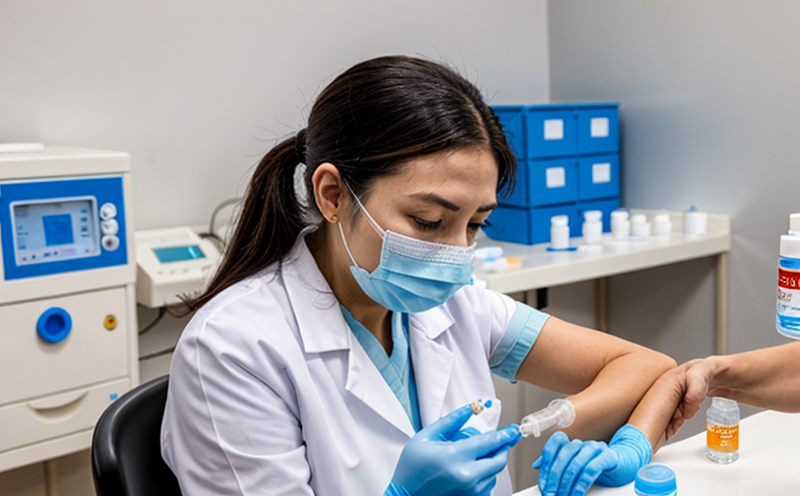ICH Q1A Stability Testing of Vaccines
The ICH (International Council for Harmonization) Guideline Q1A(R3) provides a framework for assessing the stability of pharmaceutical products, particularly vaccines. This guideline ensures that the quality and safety of vaccines are maintained throughout their shelf life. Stability testing is crucial in vaccine development as it helps manufacturers understand how environmental factors affect the integrity and efficacy of the product.
The primary objective of ICH Q1A(R3) is to evaluate the chemical, physical, biological, and microbiological properties of a vaccine over time under various stress conditions. These tests are conducted to determine the appropriate shelf life of the vaccine and ensure that it remains safe and efficacious for its intended use.
ICH Q1A stability testing typically involves three environmental stress tests: temperature, humidity, and light exposure. Each test is designed to simulate real-world storage conditions under which a vaccine might be exposed during transport or storage. The standard test duration is 12 months; however, this can vary based on the specific requirements of the product.
Before initiating stability testing, it's essential to understand the intended use and distribution of the vaccine. This information helps in designing an appropriate test protocol that reflects real-world conditions. For instance, if a vaccine will be stored at higher temperatures during transportation, then the stability tests should include exposure to higher temperature ranges.
The ICH Q1A(R3) guideline recommends conducting accelerated testing and long-term testing simultaneously. Accelerated testing uses higher than ambient conditions (typically 40°C/75% RH for temperature and humidity) to shorten the time it takes to observe potential degradation. Conversely, long-term testing is conducted at more representative conditions to predict the shelf life under actual storage conditions.
During stability testing, various analytical methods are employed to assess different aspects of vaccine quality:
- Chemical Analysis: To monitor changes in active ingredients and excipients over time.
- Physical Properties: Testing includes viscosity, particle size distribution, and sedimentation rates.
- Biological Activity: Assays to evaluate the potency of the vaccine at different storage conditions.
- Microbial Quality: Ensuring that the product remains free from contamination throughout its shelf life.
The results of these tests are compared against predefined acceptance criteria specified in relevant international standards such as ISO, ASTM, and ICH guidelines. Compliance with these standards is critical for ensuring regulatory approval and market access.
Proper specimen preparation is crucial for accurate stability testing. Samples should be prepared according to the protocol outlined in ICH Q1A(R3) to ensure consistency across different batches of the vaccine. This includes using appropriate containers, labeling samples correctly, and storing them under controlled conditions until testing begins.
The choice of instrumentation can significantly impact the accuracy and reproducibility of stability tests. Commonly used equipment includes high-performance liquid chromatography (HPLC), capillary electrophoresis (CE), and Fourier-transform infrared spectroscopy (FTIR). These instruments allow for precise measurement of chemical composition changes, which are critical indicators of vaccine stability.
Once the testing is complete, a comprehensive report summarizing all findings must be prepared. This document should include raw data, statistical analyses, and interpretations supported by relevant references to ICH guidelines and other regulatory documents. Compliance with these standards ensures that the manufacturer meets both internal quality control objectives and external regulatory requirements.
Stability testing plays a vital role in ensuring public health by maintaining vaccine efficacy and safety throughout its lifecycle. By adhering strictly to ICH Q1A(R3) protocols, manufacturers can provide reliable products that meet stringent regulatory standards.
Frequently Asked Questions
Why Choose This Test
- Ensures Compliance: Adherence to ICH guidelines is essential for regulatory approval and market access.
- Enhances Product Quality: By identifying potential issues early, stability testing helps maintain high standards of vaccine quality throughout its lifecycle.
- Supports Regulatory Requirements: Compliance with ICH Q1A(R3) ensures that all necessary data points are covered, facilitating smoother regulatory processes.
The ICH Q1A(R3) stability testing process is designed to be comprehensive and rigorous. It involves multiple stages of analysis aimed at understanding the impact of environmental factors on vaccine stability. This thorough approach not only enhances product quality but also supports compliance with regulatory requirements, ensuring that vaccines meet stringent safety and efficacy standards.
Use Cases and Application Examples
The ICH Q1A(R3) guideline is widely applicable across various stages of vaccine development and manufacturing. Here are some specific use cases:
- New Product Introduction: Conducting stability tests helps in establishing the appropriate shelf life for a newly developed vaccine.
- Process Optimization: Stability data can be used to refine production processes, ensuring that the final product meets all quality criteria.
- Batch Release Testing: Each batch of the vaccine undergoes stability testing before being released for distribution. This ensures consistency and reliability.
- Packaging Design: Understanding how packaging affects the stability of a vaccine can lead to better design decisions, enhancing overall product quality.
These examples illustrate the versatility and importance of ICH Q1A(R3) stability testing in ensuring that vaccines are safe, effective, and reliable. By incorporating these tests into their workflows, manufacturers can build confidence among regulatory bodies and healthcare providers.
Environmental and Sustainability Contributions
The environmental impact of pharmaceutical products is increasingly being recognized as a critical factor in overall sustainability efforts. ICH Q1A(R3) stability testing contributes positively to the environment by:
- Reducing Waste: By ensuring that vaccines remain stable and effective, this process minimizes wastage during transportation and storage.
- Optimizing Storage Conditions: Understanding how different environmental factors affect vaccine stability can lead to more efficient storage practices, which in turn reduces energy consumption.
- Supporting Regulatory Compliance: Ensuring compliance with international standards helps streamline regulatory processes, potentially reducing the time and resources needed for approval.
In conclusion, ICH Q1A(R3) stability testing is not only crucial for maintaining high-quality vaccines but also plays a role in promoting environmental sustainability. Through careful planning and execution of these tests, manufacturers can contribute to both public health and planetary well-being.





